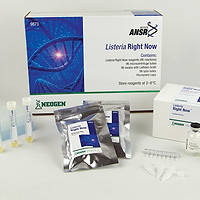Simplicity and Accuracy in Environmental Testing

In 2008, the U.S. Centers for Disease Control and Prevention’s (CDC) FoodNet surveillance system reported that the number of infections of Salmonella was the highest among all reported foodborne illnesses. Despite the increasing regulation governing testing and control of Salmonella in the processing environment, it remains a threat to consumer product safety. Testing for Salmonella and inspection of processing environments will need to constantly improve to assure safety.
Salmonellosis Increasing in Ready-to-Eat, Low-Moisture Foods
Typically, the food industry associates raw meat as a vehicle for salmonellosis infection. Chocolate, powdered infant formula and raw almonds are a few examples of these ready-to-eat, low-moisture products that have been related to a number of salmonellosis outbreaks.
The reason ready-to-eat, low-moisture products aren't categorized as vehicles for salmonellosis infection and, therefore, not of concern for consumers, is that many times Salmonella is present in low numbers. It has been documented that salmonellosis infection has occurred from contamination levels as low as 1 CFU/g. The high-fat nature of these foods has been shown to protect the Salmonella organism against the acidic conditions of the digestive tract, thus increasing the likelihood of individuals getting sick by consuming foods that are contaminated with low levels of the pathogen. Due to these factors, it has become extremely important to screen ready-to-eat, low-moisture foods for the presence of Salmonella.
Cross-Contamination in Processing
So how does one design a testing and sampling protocol that is able to pick up that potential single cell in a lot of peanut butter or other ready-to-eat, low-moisture product? The answer is to catch the contamination before it gets into the product. Investigations of outbreaks related to ready-to-eat, low-moisture foods indicate that Salmonella contamination of these foods occurred because of cross-contamination within the processing environment. Poor sanitation practices, poor equipment design, improper maintenance of equipment and poor raw material control all contribute to possibility of contaminating the processing environment with Salmonella.
The documented outbreaks related to ready-to-eat, low-moisture foods underscore the difficulty of eradicating Salmonella from manufacturing facilities and highlights the need to reinforce industry preventive control measures. The food industry needs a method that is affordable, demonstrates fast and accurate results and provides a complete solution to ensure that these products do not become contaminated and that contaminated product does not reach the consumer.
A Solution to the Problem
The RapidChek® SELECT Salmonella test is validated, affordable, simple and accurate. The system uses patented, phage-supplemented media coupled with a lateral flow device to provide a sensitive, specific Salmonella test. The phages in the primary enrichment reduce or eliminate both cross-reactive and competitive bacteria, allowing for an optimal environment for fast Salmonella growth and faster Salmonella detection, which is especially important when the microbe is present at very low levels.
It is critical that a testing method provides maximum assurance of reliability in the results through documented data. This test has been AOAC-RI validated for testing peanut butter samples in as little as 22 hours and 10 minutes. The same method recently has been validated on testing environmental samples for the presence of Salmonella. The ability to obtain an answer in so little time allows food manufacturers to release product and implement corrective actions more quickly.
Compromise Is Not an Option
Food companies should not be asked to compromise on Salmonella testing. They can have ease-of-use, improved training efficiencies, reduced product hold-time and reduced testing costs. Labs that have implemented the RapidChek SELECT Salmonella system have realized a measurable reduction in their testing costs. Moreover, there is no need for up-front expense on automated equipment, annual maintenance fees or binding contracts.
The top reasons for choosing RapidChek SELECT Salmonella are the following:
1. Accurate Results. Any detection system for Salmonella must be sensitive, specific and reproducible. It is important that the method has very low levels of false positives and negatives. RapidChek SELECT Salmonella has been AOAC-RI validated to detect levels as low as 1 CFU/25 g and has been proven to have 99% sensitivity and 100% specificity.
2. Lowest Total Cost-in-Use. Users must understand a method’s “true” costs, recognizing that the price of test materials is the smallest cost associated with testing. Greater costs include time to actionable results, analyst hands-on time and lab equipment requirements.
3. Simplicity. In today’s business environment, staff turnover can be an issue. Continual training of new staff on a complex method is exhausting and a drain on company resources. Employ a method that is highly accurate and easy-to-use to reduce the number of potential errors during transfer and preparation steps.
4. Shortest Time to Result. Users must choose assays that will give results in a timely fashion. This system was developed to reduce the time required for the detection of pathogens.
www.sdix.com
Looking for a reprint of this article?
From high-res PDFs to custom plaques, order your copy today!





